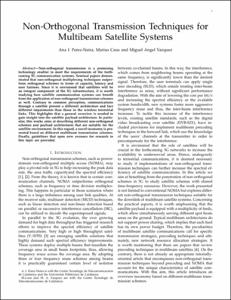Mostra el registre d'ítem simple
Non-orthogonal transmission techniques for multibeam satellite systems
| dc.contributor.author | Pérez Neira, Ana Isabel |
| dc.contributor.author | Caus, Marius |
| dc.contributor.author | Vázquez Oliver, Miguel Ángel |
| dc.contributor.other | Universitat Politècnica de Catalunya. Departament de Teoria del Senyal i Comunicacions |
| dc.date.accessioned | 2020-02-17T19:04:29Z |
| dc.date.available | 2020-02-17T19:04:29Z |
| dc.date.issued | 2019-12-01 |
| dc.identifier.citation | Perez, A.; Caus, M.; Vázquez, M. Non-orthogonal transmission techniques for multibeam satellite systems. "IEEE communications magazine", 1 Desembre 2019, vol. 57, núm. 12, p. 58-63. |
| dc.identifier.issn | 0163-6804 |
| dc.identifier.uri | http://hdl.handle.net/2117/177885 |
| dc.description | © 2019 IEEE. Personal use of this material is permitted. Permission from IEEE must be obtained for all other uses, in any current or future media, including reprinting/republishing this material for advertising or promotional purposes,creating new collective works, for resale or redistribution to servers or lists, or reuse of any copyrighted component of this work in other works. |
| dc.description.abstract | Non-orthogonal transmission is a promising technology enabler to meet the requirements of 5G communication systems. Seminal papers demonstrated that non-orthogonal multiplexing techniques outperform orthogonal schemes in terms of capacity, latency, and user fairness. Since it is envisioned that satellites will be an integral component of the 5G infrastructure, it is worth studying how satellite communication systems can benefit from the application of non-orthogonal transmission schemes as well. Contrary to common perception, current communications through a satellite present a different architecture and face different impairments than those in the wireless terrestrial links. In particular, this work aims to describe different non-orthogonal schemes that are suitable for the forward link (i.e., satellite to user). In contrast with the return link of the satellite (i.e., user to satellite), where the use of non-orthogonal transmission schemes has been widely studied, less effort has been devoted to the forward link. In light of this, this article provides an overview and a novel taxonomy that is based on the forward link of different non-orthogonal multibeam transmission schemes. Finally, guidelines that open new avenues for research in this topic are provided. |
| dc.format.extent | 6 p. |
| dc.language.iso | eng |
| dc.subject | Àrees temàtiques de la UPC::Enginyeria de la telecomunicació::Radiocomunicació i exploració electromagnètica::Satèl·lits i ràdioenllaços |
| dc.subject | Àrees temàtiques de la UPC::Enginyeria de la telecomunicació::Radiocomunicació i exploració electromagnètica::Comunicacions mòbils |
| dc.subject.lcsh | Artificial satellites in navigation |
| dc.subject.lcsh | Mobile communication systems |
| dc.subject.other | Satellites |
| dc.subject.other | 5G mobile communication |
| dc.subject.other | Multiplexing |
| dc.subject.other | Satellite communication |
| dc.subject.other | Wireless communication |
| dc.subject.other | NOMA |
| dc.title | Non-orthogonal transmission techniques for multibeam satellite systems |
| dc.type | Article |
| dc.subject.lemac | Satèl·lits artificials en navegació |
| dc.subject.lemac | Comunicacions mòbils, Sistemes de |
| dc.identifier.doi | 10.1109/MCOM.001.1900249 |
| dc.description.peerreviewed | Peer Reviewed |
| dc.relation.publisherversion | https://ieeexplore.ieee.org/document/8930827 |
| dc.rights.access | Open Access |
| local.identifier.drac | 26917239 |
| dc.description.version | Postprint (author's final draft) |
| dc.relation.projectid | info:eu-repo/grantAgreement/AEI/Plan Estatal de Investigación Científica y Técnica y de Innovación 2013-2016/TEC2017-88373-R/ES/REDES 5G EFICIENTES EN RECURSOS/ |
| local.citation.author | Perez, A.; Caus, M.; Vázquez, M. |
| local.citation.publicationName | IEEE communications magazine |
| local.citation.volume | 57 |
| local.citation.number | 12 |
| local.citation.startingPage | 58 |
| local.citation.endingPage | 63 |
Fitxers d'aquest items
Aquest ítem apareix a les col·leccions següents
-
Articles de revista [2.526]


